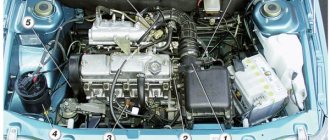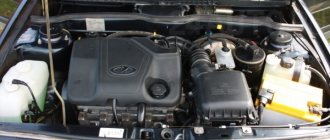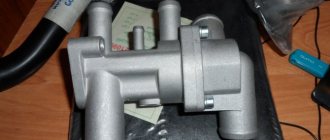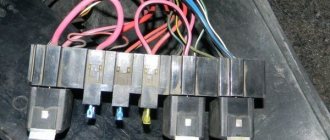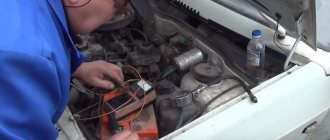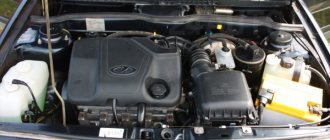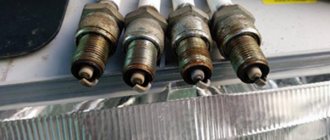After buying the car, I noticed that at idle the engine heats up very quickly and, having passed 90 degrees, it also continues to increase until the propeller turns on (about 115 degrees). When driving, everything is fine, it maintains a stable 90, when you get up at a traffic light or in a traffic jam, everything starts to rise.
I changed the thermostat and completely replaced the antifreeze with a new one (when I bought it, it was filled with water or something like that, an incomprehensible thing) But the problem still remained.
I read the forums, they say this is normal. But for some reason I don’t think so...
The problem of engine overheating is well known to many owners of domestic cars. The VAZ 2110 (2111, 2112) and 2113 (2114, 2115) lines were equipped with small-volume cooling radiators, so when driving for a long time in hot summer weather, the VAZ “normally” heats up to 105-108 degrees. But if the temperature goes through the roof even after a short trip, this is a reason to think about problems with the cooling system.
A high operating temperature of the engine may also indicate serious malfunctions. But in most cases, the VAZ 2114 heats up for minor reasons, including:
- thermostat malfunction;
- malfunction of the coolant temperature sensor (DTOZH);
- malfunction of the high pressure valve in the coolant tank cap;
- clogged radiator.
Thermostat malfunction
The thermostat is one of the weak points of the VAZ. It can be found on the right side of the cylinder block when facing the vehicle. To check the thermostat, you need to warm up the car until the fan turns on and touch the lower radiator hose with your hand. If the thermostat is working properly, it should be warm.
Removing the thermostat on a VAZ 2114
A cold pipe indicates that the thermostat is stuck in the closed position. In this case, the coolant circulates around the radiator, in a small circle. Heat exchange is disrupted - the engine quickly overheats. The problem is solved by replacing the thermostat.
Why does the engine on a VAZ-2114 get hot?
Elevated coolant temperature leads to engine failure
The main culprits for excessive increases in coolant temperature are:
- jammed valve in the expansion tank cap;
- temperature sensor (DTOZH);
- inoperative cooling system fan or faulty wiring;
- faulty thermostat (see “replacing the thermostat on a VAZ-2114 with your own hands)”;
- excessively dirty radiator. Either the honeycomb or the radiator is clogged inside (the only option is to replace it with a new one)
All of the above components and parts have a significant impact on the operation of the cooling system, and in the event of a malfunction, they contribute to an increase in engine temperature above normal. Each of the parts of this system can be checked independently and if a malfunction is detected, it can be eliminated.
Diagnostics and elimination of overheating
Troubleshooting should be divided into stages and started in the following order:
- Expansion tank cap . In its design, it has a built-in valve that ensures the creation of the necessary pressure in the system. If it breaks, the antifreeze will begin to boil in the expansion tank.
Often this valve gets stuck in the open or closed position.
An open position will make it impossible to create pressure, while the liquid will not circulate normally and will begin to overheat. The closed position, on the contrary, will prevent the formed gases from leaving the system and create excess pressure at which the engine will boil. To check, just unscrew the cap and look at its internal condition; if there are traces of scale and other contaminants, the part is replaced with a new one.
Checking the expansion tank cap for scale
If you discover that the fan is operating late or does not turn on, the temperature sensor must be urgently changed.
Changing the coolant temperature sensor
We carry out a visual inspection of the cooling fan
We inspect the radiator, if necessary, dismantle and clean the honeycombs
Radiator clogged
The radiator can be clogged from the outside and inside. External contamination is associated with dust and other debris, as well as insects, entering the honeycombs. This worsens heat transfer and is manifested by frequent operation of the fan and a long operating time.
Clogged engine radiator honeycomb
A good high pressure washer solves the problem. If the radiator has been in use for a long time, the car cools and heats up worse due to deformation of the honeycombs. You can “cure” this problem by replacing the radiator.
Dashboard malfunction
The cause of incorrect readings on the dashboard may be a factory defect or a huge number of electrical faults: from a bad ground on the ECU to a failure of the voltage stabilizer (“tablet”). This can be indicated by uneven changes in temperature readings (jumps), incorrect readings of other devices, or a discrepancy between turning on the fan and the temperature readings.
This malfunction is less problematic: the car does not actually heat up, but only for the computer. But she discovers other problems that also need to be solved.
Pump malfunction
The pump rarely fails completely, so the fault can be accurately diagnosed only after removal. The most common problem with it is the impeller breaking off. It can be solved by replacing the pump. Other troubles include deformation of the pump gear and blades due to defects or mechanical wear. This fault is especially serious as it can cause the timing belt to become misaligned. And this is its uneven wear and the danger of breakage with all the sad consequences for the piston group.
Leaking cylinder head gasket
This problem is one of the rarest causes of engine overheating in VAZ 2114 cars. When it occurs, overheating is a secondary symptom that may be accompanied by a number of others:
- oil leaks from under the cylinder head;
- uneven engine operation and low compression;
- increased oil consumption, noisy engine operation and gas flow, black exhaust.
In this situation, at best, the solution would be to replace the cylinder head gasket. At worst, a major overhaul of the engine with cleaning of all internal cooling channels.
When the engine gets hot, it is dangerous not in itself, but because of its consequences. Long-term driving at elevated operating temperatures first leads to loss of properties of elastic parts: valve stem seals and piston rings. Because of this, oil consumption increases, and engine operation becomes uneven and dirty. All this leads to expensive major repairs.
The consequences of severe overheating are even more severe: the cylinder head and cylinder block are deformed and sometimes crack. An engine that has survived this can no longer be repaired.
If the VAZ 2114 coolant temperature sensor stops working. What will happen to your car? That's right, the engine will simply boil. Engine overheating is an extremely undesirable problem that, unfortunately, many motorists face.
Coolant temperature detection element
The driver has the opportunity to independently monitor the likelihood of overheating using the coolant temperature indicator. It is he who shows whether the VAZ 2114 engine is heating up or not.
Reasons why the engine may overheat
The cooling system, which can be filled with antifreeze, antifreeze or plain water, protects the internal combustion engine from overheating.
The main devices that monitor operating temperature and reduce it are:
- radiator fan, which is turned on by software when a certain temperature is reached;
- a thermostat that opens the movement of coolant in a large circle;
- temperature sensors that transmit readings to the ECU, there are several of them, they can be located either on the engine or radiator;
- electronic engine control unit.
A malfunction in any of the above components can lead to overheating. In addition to malfunctions of the above devices, overheating can be caused by both external factors and other internal faults.
External overheating
If symptoms of overheating appear, it is necessary to carry out an external inspection of the radiator, motor and cooling system.
Where is the coolant temperature sensor located?
There are three types of cooling system on cars:
In the case of the VAZ 2114, we are dealing with the latest type of cooling system, which runs on liquid antifreeze or antifreeze.
The system itself includes the following components:
- Radiator fan;
- Radiator;
- Cooling radiator;
- Cooling system jacket;
- Pump;
- Expansion tank;
- Connection pipes;
- Coolant temperature sensor.
Do not look for DTOZH on the radiator, although that is where it is located on other VAZ models. Then where is the engine temperature sensor on the VAZ 2114? On the motor block.
Symptoms of overheating
The temperature arrow tends to the red zone - soon overheating
A fully warmed-up engine has an operating temperature in the range from 92 to 102 ° C , exceeding which can cause big trouble. Its condition is monitored by a sensor that turns on the cooling fan. The fan turns on on the stock firmware at a temperature of 102 °C .
The first symptom of engine overheating is the reading on the instrument panel; in this case, its needle approaches the red indicator.
Steam from under the hood
Steam from under the hood
If steam appears from under the hood, this indicates an increased temperature of the coolant of the power unit.
Strongly heated antifreeze splashes out of the expansion tank cap and hits the hot engine elements, which is why steam is formed. In this case, wet traces will form under the car, which have a characteristic smell of coolant.
Breakdowns
The most popular and common breakdowns of DTOZH include:
- Lack of contact with the sensor;
- Break of contact, insulation disappears;
- The device stops working;
- The fan does not turn on when required.
It is also important to examine the signs of trouble. These include:
- The engine has not yet warmed up, but the fan is already starting to work;
- The engine has warmed up, but still does not work properly;
- Fuel consumption has increased significantly.
One of the common mistakes made by beginners is that they often confuse the coolant temperature indicator sensor with the coolant temperature indicator.
Sensor check
Your VAZ 2114 engine overheats, or other signs of DTOZh failure appear. This suggests that you should check this element first.
There are two verification methods, each of which we will introduce you to.
First method
Removal
- Start the car, look at the dashboard. The gauge is at maximum, but the engine is still cold. Disconnect the contacts from the meter. If after this the arrow falls as far as possible, this indicates the need to replace the coolant temperature sensor on the VAZ 2114.
- If the arrow remains at the top, at the maximum level, take a closer look at the DTOZh contacts. Often they simply short circuit to the vehicle's ground.
- The engine may heat up normally, evenly, but the gauge needle jumps in different directions. Most likely the fuses have failed.
- If the fuses are good, close the contact to ground. If the arrow immediately jumps up, then the temperature sensor has failed.
Method two
- Take a multimeter and turn it on in ohmmeter mode.
- Arm yourself with a thermometer with notches over 100 degrees Celsius.
- Prepare heat-resistant containers that will not deform due to hot coolant.
- Connect the probes of the device to the sensor terminal and the housing.
- Having connected the DTOZH, place it in a container with coolant and begin heating.
- Monitor the ohmmeter and thermometer readings at the same time.
The table shows readings that correspond to a working, serviceable sensor. Using this method, you can check the condition of the new sensor before installing it in place of the old one.
| Temperature, C | Resistance, Ohm |
| 30 | 1350-1880 |
| 50 | 585-820 |
| 70 | 280-390 |
| 90 | 155-196 |
| 110 | 87-109 |
The engine takes a long time to warm up - when should you be nervous?
It is quite possible that the engine takes a long time to warm up due to the fact that the car has such design features. For a VAZ 2107, for example, it will be difficult to move away in cold weather if the car does not run in warm-up mode for up to 5 minutes. The same story applies to old VAZ 2114 engines and many other representatives of this manufacturer. You need to worry about the condition of the car if there are such features:
- Previously, the engine warmed up much faster, but now to start normal operation you have to stand for long minutes and listen to the uneven revolutions of the unit and the dead temperature needle;
- when warming up, unprecedented symptoms began to appear - the speed fluctuates too much, the voltage in the on-board network drops, the car stalls or other anomalies occur;
- when you start driving, you feel a significant lack of power, the engine tries to pull out under load, it seems that you are dragging a heavy trailer behind you;
- when starting, you have to turn the starter for too long, warming up occurs at low speeds, the engine constantly works as if under a heavy load, and the consumption is simply enormous;
- The engine does not reach operating temperatures even after several hours of operation; this also indicates problems that should be eliminated for a normal trip.
Of course, you should not compare the summer heating mode and winter operating options, since the seasonal behavior of the machine can change greatly. But in case of such problems, along with prolonged warming up of the engine, it is worth contacting a service station. The problem is that many such troubles can have a negative effect on the operation of the car, reduce its efficiency and shorten the potential service life of many parts of the unit.
